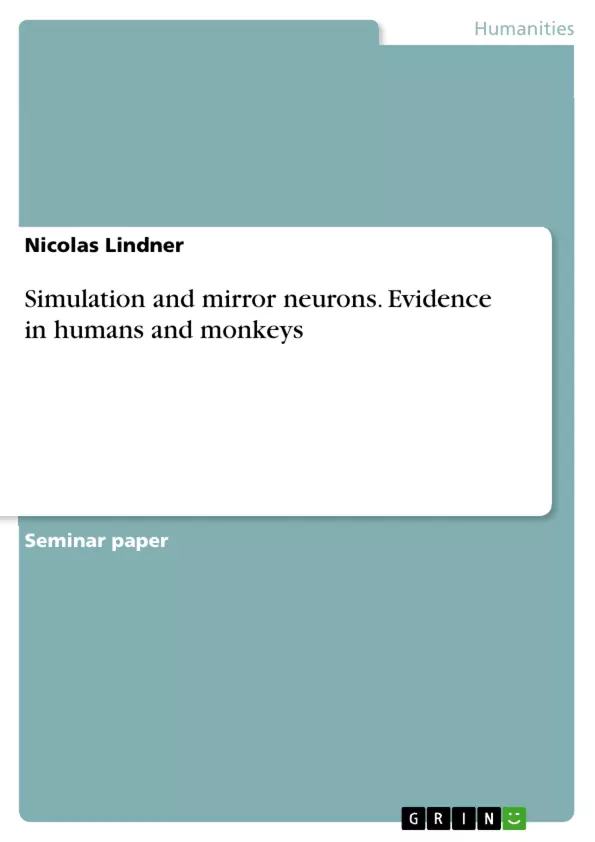In the last years there has been evidence for a special class of neurons. These so-called mirror neurons are located in the premotor cortex of monkeys and equally show activity during the performance and the observation of particular actions. Some authors interpret this function as the neural correlate of mind-reading, the ability to attribute mental states to others. Furthermore this interpretation is valued as support to a particular theory of mind theory; simulation theory, which claims that we understand the inten-tions, beliefs and emotions of others by simulating their mental processes on the basis of our own. In this paper I will review evidence for mirror neurons being the neural correlate of mind-reading. To accomplish this I will also review evidence for mirror neurons in monkeys and humans and give a short outline of simulation theory.
Inhaltsverzeichnis (Table of Contents)
- Abstract
- Introduction
- Simulation Theory
- Mirror neurons as the neural correlate of mind-reading
- Mirror neurons in monkeys and humans
- Mirror neurons and mind-reading
- Conclusions
- References
Zielsetzung und Themenschwerpunkte (Objectives and Key Themes)
This paper explores the evidence for mirror neurons as the neural correlate of mind-reading. It aims to review the theory of mind-reading, specifically simulation theory, and examine the role of mirror neurons in both monkeys and humans. The paper also critically analyzes the interpretation of mirror neuron activity as support for simulation theory. Key themes addressed in the paper include:- Simulation theory as an explanation for mind-reading
- The role of mirror neurons in action observation and execution
- The evidence for mirror neurons in both monkeys and humans
- The interpretation of mirror neuron activity as the neural correlate of mind-reading
- Critical evaluation of the evidence supporting the link between mirror neurons and mind-reading
Zusammenfassung der Kapitel (Chapter Summaries)
- Introduction: This chapter introduces the concept of mind-reading and explores different approaches to understanding how we attribute mental states to others. It highlights simulation theory (ST) as a prominent explanation for mind-reading, proposing that we simulate the mental states of others using our own mental processes. The chapter also mentions the discovery of mirror neurons (MNs) and their potential role in mind-reading.
- Simulation Theory: This chapter provides a detailed overview of ST. It describes the theory's core principle, which is that we use our own minds as models to simulate the mental states of others. The chapter also explains the three steps involved in the simulation process: generating "pretend" mental states, feeding these states into our own mental processing, and assigning the output of this processing to the other person. It also emphasizes the importance of the similarity between the "pretend" and actual mental states.
- Mirror neurons as the neural correlate of mind-reading: This chapter examines the evidence for MNs in both monkeys and humans, arguing that they are a potential neural basis for mind-reading. It presents research findings on MN activity during action observation and execution, suggesting that these neurons play a role in understanding the intentions and actions of others. The chapter then explores the interpretation of MN activity as support for ST, suggesting that they may facilitate the simulation process described in the previous chapter.
Schlüsselwörter (Keywords)
The core focus of this paper lies in the interplay between simulation theory, mirror neurons, and mind-reading. Key terms and concepts include: simulation theory, mind-reading, mirror neurons, neural correlate, action observation, action execution, mental states, intentions, beliefs, desires, premotor cortex, monkeys, humans, and empirical evidence.- Arbeit zitieren
- B.A. Nicolas Lindner (Autor:in), 2011, Simulation and mirror neurons. Evidence in humans and monkeys, München, GRIN Verlag, https://www.grin.com/document/180662



